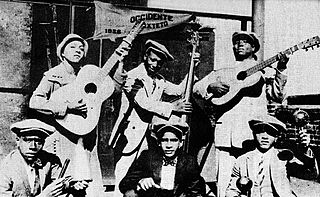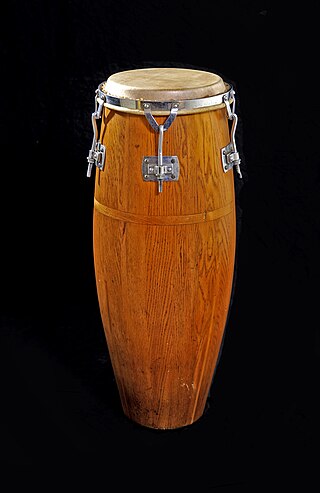Related Research Articles
The term rumba may refer to a variety of unrelated music styles. Originally, "rumba" was used as a synonym for "party" in northern Cuba, and by the late 19th century it was used to denote the complex of secular music styles known as Cuban rumba. Since the early 20th century the term has been used in different countries to refer to distinct styles of music and dance, most of which are only tangentially related to the original Cuban rumba, if at all. The vague etymological origin of the term rumba, as well as its interchangeable use with guaracha in settings such as bufo theatre, is largely responsible for such worldwide polysemy of the term. In addition, "rumba" was the primary marketing term for Cuban music in North America, as well as West and Central Africa, during much of the 20th century, before the rise of mambo, pachanga and salsa.

Úrsula Hilaria Celia de la Caridad Cruz Alfonso, known as Celia Cruz, was a Cuban singer and one of the most popular Latin artists of the 20th century. Cruz rose to fame in Cuba during the 1950s as a singer of guarachas, earning the nickname "La Guarachera de Cuba". In the following decades, she became known internationally as the "Queen of Salsa" due to her contributions to Latin music. She had sold over 10 million copies, making her one of the best-selling Latin music artists.
The music of Cuba, including its instruments, performance, and dance, comprises a large set of unique traditions influenced mostly by west African and European music. Due to the syncretic nature of most of its genres, Cuban music is often considered one of the richest and most influential regional music in the world. For instance, the son cubano merges an adapted Spanish guitar (tres), melody, harmony, and lyrical traditions with Afro-Cuban percussion and rhythms. Almost nothing remains of the original native traditions, since the native population was exterminated in the 16th century.

Celina González Zamora was a Cuban singer-songwriter, who specialized in "música campesina", traditional music of the Cuban countryside. She is best known for co-authoring A Santa Bárbara with her partner Reutilio Domínguez. Her recording of it was a hit, as was Celia Cruz's version. González and Domínguez wrote "Yo soy el punto cubano": the recording was a hit in many countries throughout the world.
Los Muñequitos de Matanzas is a Cuban rumba ensemble from the city of Matanzas. The group was established in 1952 as Conjunto Guaguancó Matancero and released their first LP in 1956 through Puchito. Since then, Los Muñequitos have continued to perform and record, becoming one of the most successful and critically acclaimed rumba groups of all time.
A descarga is an improvised jam session consisting of variations on Cuban music themes, primarily son montuno, but also guajira, bolero, guaracha and rumba. The genre is strongly influenced by jazz and it was developed in Havana during the 1950s. Important figures in the emergence of the genre were Cachao, Julio Gutiérrez, Bebo Valdés, Peruchín and Niño Rivera in Cuba, and Tito Puente, Machito and Mario Bauzá in New York. Originally, descargas were promoted by record companies such as Panart, Maype and Gema under the label Cuban jam sessions. From the 1960s, the descarga format was usually adapted by large salsa ensembles, most notably the Fania All-Stars.
Guaguancó is a subgenre of Cuban rumba, combining percussion, voices, and dance. There are two main styles: Havana and Matanzas.
Changuito is a Cuban percussionist.

Ignacio Piñeiro Martínez was a Cuban musician, bandleader and composer whose career started in rumba and flowered in the rise of the son. He was one of the most important composers of son music; in total he wrote about 327 numbers, mostly sones.

Rumba is a secular genre of Cuban music involving dance, percussion, and song. It originated in the northern regions of Cuba, mainly in urban Havana and Matanzas, during the late 19th century. It is based on African music and dance traditions, namely Abakuá and yuka, as well as the Spanish-based coros de clave. According to Argeliers León, rumba is one of the major "genre complexes" of Cuban music, and the term rumba complex is now commonly used by musicologists. This complex encompasses the three traditional forms of rumba, as well as their contemporary derivatives and other minor styles.

Trova is a style of Cuban popular music originating in the 19th century. Trova was created by itinerant musicians known as trovadores who travelled around Cuba's Oriente province, especially Santiago de Cuba, and earned their living by singing and playing the guitar. According to nueva trova musician Noel Nicola, Cuban trovadors sang original songs or songs written by contemporaries, accompanied themselves on guitar, and aimed to feature music that had a poetic sensibility. This definition fits best the singers of boleros, and less well the Afrocubans singing funky sones or even guaguancós and abakuá. It rules out, perhaps unfairly, singers who accompanied themselves on the piano.
Haila María Mompié González, better known as Haila Mompié or simply Haila, is a Cuban singer, specializing in son and timba. She is known as the lead vocalist in Azúcar Negra, as a former Bamboleo singer, and for her solo career.

The quinto is the smallest and highest pitched type of conga drum. It is used as the lead drum in Cuban rumba styles such as guaguancó, yambú, columbia and guarapachangueo, and it is also present in congas de comparsa. Quinto phrases are played in both triple-pulse and duple-pulse structures. In columbia, triple pulse is the primary structure and duple pulse is secondary. In yambú and guaguancó duple-pulse is primary and triple-pulse is secondary.

Mercedes Valdés Granit, better known as Merceditas Valdés, was a Cuban singer who specialized in Afro-Cuban traditional music. Under the aegis of ethnomusicologists Fernando Ortiz and Obdulio Morales, Valdés helped popularize Afro-Cuban music throughout Latin America. In 1949, she became one of the first female Santería singers to be recorded. Her debut album was released at the start of the 1960s, when the Cuban government nationalized the record industry. She then went on hiatus before making a comeback in the 1980s with a series of albums entitled Aché, in collaboration with artists such as Frank Emilio Flynn and rumba ensemble Yoruba Andabo. She also appeared in Jane Bunnett's Spirits of Havana and continued performing until her death in 1996.
Alberto Zayas Govín was a Cuban rumba singer and songwriter who founded one of the first recorded rumba ensembles, Grupo Afrocubano Lulú Yonkori. He is considered one of the most important guaguancó vocalists/composers in the history of rumba.
Francisco Hernández Mora, better known as Pancho Quinto, was a Cuban rumba percussionist and teacher. He was the founder of Yoruba Andabo and one of the "godfathers" of the guarapachangueo style of Cuban rumba. His solo career began in the 1990s after he gained international attention through his collaborations with Jane Bunnett and other artists.

A Toda Cuba le Gusta is the first studio album by the Afro-Cuban All Stars, produced by Cuban bandleader and musician Juan de Marcos González and Nick Gold, and released on April 9, 1997 on World Circuit Records.

Pedro Lugo Martínez, better known as El Nene, is a Cuban singer. He specializes in both son cubano and rumba, having sung for La Monumental, Clave y Guaguancó and Conjunto Chappottín. He is also the founder and lead vocalist of Jóvenes Clásicos del Son, a traditional son septet founded in 1994. In 2006, he formed another son septet, Son del Nene, in which he is also the lead vocalist. He has recorded albums in collaboration with Celeste Mendoza, Tata Güines, Estrellas de Areito and rumba ensembles such as Rapsodia Rumbera and Team Cuba de la Rumba.
"Castillo mangüé", also known as "Chévere mangüé", is a traditional Cuban pregón often played as a yambú, son or guaracha. According to Helio Orovio, it is an example of an orally transmitted yambú still performed today.
"La chismosa del solar" is a guaguancó written by Miguel Sarría and first recorded by Los Muñequitos de Matanzas in 1970. The song was covered in 1975 by Alfredo "Chocolate" Armenteros ("Nicolasa") and Sonora Ponceña and released on LP and single format by both artists. A standard of the rumba repertoire, the song was reworked by Lázaro Rizo, a member of Pancho Quinto's group, as "Lenguasá", also known as "Tremendo chuchuchú", which was covered by Orquesta Revé on their successful 1991 album Mi salsa tiene sandunga. The song was later recorded by Pancho Quinto, featuring Omar Sosa on piano, and it has since been covered by other rumba ensembles such as Grupo Mezcla and Rumberos de Cuba.
References
- 1 2 Peter Watrous (27 November 1998). "Celeste Mendoza, 68, Cuban Rumba Singer". New York Times. Retrieved 7 June 2011.
- 1 2 Sweeney, Philip (2001). The rough guide to Cuban music . Rough Guides. pp. 36–8. ISBN 978-1-85828-761-4.